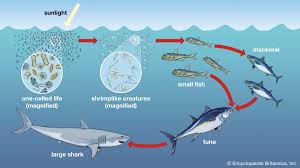
Title: Decoding the Food Chain: A Guide to Nutrition, Well-being, and Organic Choices
Description:
Unlock the secrets of the food chain and its vital role in our nutrition and well-being. Explore how understanding this interconnected web can guide us towards healthier choices, focusing on organic options for a more sustainable and nourishing diet.
Decoding the Food Chain: A Guide to Nutrition, Well-being, and Organic Choices
The food chain is more than just a concept learned in elementary science. It’s a fundamental principle that governs the flow of energy and nutrients through our entire ecosystem, and it plays a crucial role in our individual nutrition and well-being. By understanding how energy is transferred from one organism to another, we can make more informed decisions about the food we consume, promoting both personal health and environmental sustainability. In this article, we’ll delve into the intricacies of the food chain, exploring its components, impact on our diet, and the benefits of prioritizing organic choices within this interconnected system, focusing on the food chain.

The Core Components of the Food Chain and Nutrition and Well-being
At its simplest the food chain illustrates who eats whom in a given environment. But beneath this simple concept lies a complex network of interactions that are essential for life. Here’s a breakdown of the key players:
-
Producers (Autotrophs): These are the foundation of any food chain. Producers, primarily plants, but also algae and some bacteria, create their own food through photosynthesis. They convert sunlight, water, and carbon dioxide into energy-rich compounds like sugars. They are the only organisms capable of converting inorganic matter into organic matter.
-
Consumers (Heterotrophs): Consumers cannot produce their own food and rely on consuming other organisms for energy. They are classified into several categories:
-
Primary Consumers (Herbivores): These organisms feed directly on producers. Examples include rabbits, cows, grasshoppers, and deer.
-
Secondary Consumers (Carnivores or Omnivores): These organisms feed on primary consumers. Examples include snakes that eat rabbits, foxes that eat birds, and humans who eat vegetables.
-
Tertiary Consumers (Carnivores): These are top-level predators that feed on secondary consumers. Examples include eagles that eat snakes and sharks that eat fish.
-
Omnivores: These consumers eat both plants and animals. Humans, bears, and chickens are examples of omnivores.
-
-
Decomposers (Detritivores): Decomposers, like bacteria, fungi, and earthworms, break down dead organisms and organic waste, releasing nutrients back into the environment. These nutrients are then used by producers, completing the cycle. Decomposers are essential for maintaining a healthy ecosystem and preventing the accumulation of dead organic matter.
The flow of energy in the food chain is unidirectional. Energy is transferred from one trophic level (a level in the food chain) to the next. However, at each transfer, a significant amount of energy is lost as heat (through metabolic processes). This is why food chains typically have a limited number of trophic levels – usually no more than four or five. The higher up the food chain you go, the less energy is available. This energy loss also explains why there are fewer top predators than primary producers in an ecosystem.
How the Food Chain Impacts Our Diet and Nutrition and Well-being
The food chain directly impacts the quality and availability of the nutrients we obtain from our diet. Understanding this connection is crucial for making informed food choices and promoting overall well-being.
-
Nutrient Density: The nutritional value of the food we consume is dependent on the nutritional value of the organisms it consumes. For example, grass-fed beef tends to be higher in omega-3 fatty acids and conjugated linoleic acid (CLA) compared to grain-fed beef, because the grass the cattle eat is rich in these nutrients. Similarly, the quality of the soil in which fruits and vegetables are grown directly impacts their nutrient content.
-
Bioaccumulation: Harmful substances, such as pesticides, heavy metals, and industrial pollutants, can accumulate in organisms as they move up the food chain. This phenomenon, known as bioaccumulation, means that top predators often have higher concentrations of these toxins than organisms lower down the chain. Consuming foods high on the food chain, like certain types of fish, can increase our exposure to these harmful substances.
-
Sustainability: Our dietary choices impact the health and sustainability of the entire food chain. Overfishing, deforestation, and unsustainable agricultural practices can disrupt the delicate balance of ecosystems, leading to food shortages, environmental degradation, and reduced biodiversity. Choosing sustainable food sources, such as locally sourced produce, sustainably harvested seafood, and pasture-raised meats, helps to minimize our impact on the environment and support a healthy food chain.
-
Organic Farming and Food Chain Integrity: Organic farming practices prioritize soil health, biodiversity, and natural pest control. By avoiding synthetic pesticides, herbicides, and fertilizers, organic farming minimizes the risk of bioaccumulation and promotes a healthier food chain. Organic produce tends to be richer in nutrients and antioxidants compared to conventionally grown produce, contributing to improved nutrition and well-being. Organic farming also supports beneficial soil microbes, enhancing decomposition and nutrient cycling.
The Benefits of Choosing Organic Within the Food Chain for Nutrition and Well-being
Choosing organic options within the food chain offers a range of benefits for both personal health and environmental sustainability:
-
Reduced Exposure to Harmful Chemicals: Organic farming prohibits the use of synthetic pesticides, herbicides, and fertilizers, reducing our exposure to these potentially harmful chemicals. Studies have linked exposure to pesticides to a variety of health problems, including neurological disorders, reproductive issues, and cancer.
-
Higher Nutrient Content: While research is ongoing, many studies suggest that organic produce tends to be richer in certain nutrients and antioxidants compared to conventionally grown produce. This may be due to the emphasis on soil health and the absence of synthetic fertilizers, which can disrupt nutrient uptake by plants.
-
Improved Soil Health: Organic farming practices, such as crop rotation, cover cropping, and composting, enhance soil health, leading to improved water retention, increased biodiversity, and reduced erosion. Healthy soil is essential for growing nutrient-rich crops and maintaining a sustainable food chain.
-
Enhanced Biodiversity: Organic farms tend to have greater biodiversity than conventional farms, supporting a wider range of plant and animal species. This is due to the absence of synthetic pesticides and herbicides, which can harm beneficial insects and other wildlife.
-
Reduced Environmental Impact: Organic farming minimizes the environmental impact of agriculture by reducing pollution, conserving water, and mitigating climate change. Organic farms tend to have lower greenhouse gas emissions than conventional farms, and they also sequester more carbon in the soil.
-
Supporting Sustainable Agriculture: By choosing organic products, we support farmers who are committed to sustainable agriculture practices. This helps to create a more resilient and equitable food system that benefits both people and the planet.
Practical Steps for Making Food Chain-Conscious Choices
Here are some practical steps you can take to make more informed food choices and support a healthier, more sustainable food chain:
-
Eat Lower on the Food Chain: Prioritize plant-based foods, such as fruits, vegetables, grains, and legumes. These foods are lower on the food chain, meaning they require less energy to produce and have a smaller environmental impact.
-
Choose Organic Whenever Possible: Opt for organic produce, dairy, and meat to reduce your exposure to harmful chemicals and support sustainable farming practices.
-
Buy Local and Seasonal: Purchasing food from local farmers markets and Community Supported Agriculture (CSA) programs reduces transportation costs, supports local economies, and ensures that your food is fresh and in season.
-
Choose Sustainable Seafood: Select seafood that is harvested using sustainable fishing practices to protect marine ecosystems and prevent overfishing. Look for certifications such as the Marine Stewardship Council (MSC).
-
Reduce Food Waste: Minimize food waste by planning meals, storing food properly, and composting food scraps. Food waste contributes to greenhouse gas emissions and wastes valuable resources.
-
Be Mindful of Portion Sizes: Eating smaller portions can help to reduce your overall consumption and minimize your impact on the environment.
-
Educate Yourself: Learn more about the food chain, sustainable agriculture, and the environmental impact of your food choices. The more you know, the better equipped you’ll be to make informed decisions.
Conclusion: Embracing the Food Chain for a Healthier Future
The food chain is a complex and interconnected system that plays a vital role in our nutrition and well-being. By understanding how energy and nutrients flow through the food chain, we can make more informed choices about the food we eat, promoting both personal health and environmental sustainability. Prioritizing organic options, supporting local farmers, and reducing food waste are just a few of the ways we can contribute to a healthier, more resilient food chain. Ultimately, embracing the principles of the food chain is essential for creating a sustainable and equitable food system that benefits both people and the planet.
By understanding the intricacies of the food chain and making conscious choices about what we eat, we can positively impact our nutrition and well-bei\ng and contribute to a healthier, more sustainable future for all.
